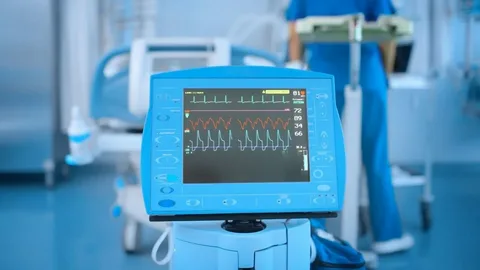Cardiac monitoring remains an important process for identifying, diagnosing, and managing many forms of heart disease. Because cardiovascular diseases are becoming more common, the need to use modern technology and accurate devices to obtain the necessary data for the beginning of interventions is critical. Discussion of the elements essential for cardiac monitoring and treatment is the subject of this article, and the place of ECG medical devices is emphasized because of their ability to provide important data concerning the patient’s condition.
1.Cardiac monitoring in critical illness: A conceptual model:
Supervision of the heart’s activity involves the recording of the heart status in a continuous or periodic manner. It helps one’s doctor figure out the levels of electricity in the heart, the pace at which the heart is beating, and if something is wrong within the heart’s system. It is critical and can be performed in both inpatient and outpatient settings, particularly with clients diagnosed with cardiovascular conditions, because this allows assessment of disease dynamics and management of therapeutically relevant processes.
2.The Function of ECG Devices in Cardiac Checks:
Electrocardiography (ECG) is a noninvasive technique for evaluating the electrical activities of the cardiac muscle. This activity is captured by an ECG medical device, which produces a representation in the form of waves. These patterns contain valuable information about the rhythm of the heart, signals in the heart muscle, and muscle contractions.
3.The Mechanics of an ECG Medical Device:
An ECG device is made of electrodes that are applied to the patient’s skin; common areas include the chest, wrists, and ankles. The electrodes then pick up electrical impulses from the heart, which are then transmitted through an ECG machine. This recorded data is then depicted as wave-like patterns on screens from which specialists can easily diagnose the heart.
4.Electrodes: The Critical Link in ECG Monitoring:
Electrodes for ECG are crucial, more so due to their prospects of being produced in a range of affordable alternatives for use in various categories of patients. These are small, shaped like patches and stick on the skin, thus working like sensors that monitor the heart’s electrical signals. The electrodes translate these signals into forms that the ECG machine analyzes and produces readable formations.
5.Nature and Uses of Different Electrodes:
Electrodes come in various forms, each suitable for different monitoring needs:
- Disposable Electrodes: They are disposable electrodes often in use where there is a likelihood of cross-infection, such as in busy hospitals.
- Reusable Electrodes: For use when they are expected to be used for extended periods, these are commonly applied in places whereby the level of hygiene may be easily regulated.
- Dry Electrodes: Suitable to be used in patients with sensitive skin in that they do not require the use of gels or adhesives.
- Wet Gel Electrodes: Implanted electrodes may be submitted in some conductive gel to boost signal acquisition, mostly applied for temporary purposes.
The choice of electrodes is based on the requirements and necessity of patient monitoring duration and others.
6.Functions and significance of conductive gels and adhesives:
There is little doubt that conductive gels and adhesives have a critical role to play in ECG monitoring because they offer low skin impedance and optimize the quality of signals sent. It also improves the intensive contact of electrodes with skin to provide a clear reading compared to the ordinary gel.
Products such as TENS adhesive gel are popular in ECG electrodes, particularly for patients receiving TENS treatments together with cardiac testing. The gels above offer not only adhesion properties but also conductivity, reducing discomfort caused by prolonged use.
7.The Role of Wireless Technology in Cardiovascular Care:
Wireless ECG technology has revolutionized cardiac monitoring. Wireless ECG devices communicate with mobile applications or cloud systems, allowing for seamless data transmission and analysis. This feature is particularly valuable for patients who require regular monitoring but cannot frequently visit healthcare facilities.
8.Patient Protection in the Monitoring and Treatment of Heart Diseases:
The principal determinant of cardiac monitoring is patient safety. To have accurate, reliable data, medical personnel that work with these devices have to make sure that all the devices are fine-tuned or at their optimum performance. Furthermore, though quality electrodes are recommended for monitoring systems, the latter should involve fail-safe features to remind users of mistakes or breaks in monitoring. Training and calibration of ECG devices are also important to reduce the risks of faulty data as much as possible.
9.Monitoring and Therapy: The combined model for cardiac health:
Contemporary cardiac care includes both monitoring and therapy at one or the other. For example, ICDs or pacemakers track the activity of the heart, and if it is abnormal, then it corrects automatically by giving the heart an electrical shock. Integrated diagnosis and therapy in one device allow patients to have a more effective approach to the correct treatment of heart disorders.
10.The Future of Cardiac Monitoring and Therapy:
With advancements in technology, cardiac monitoring devices are likely to get smaller in size, accurate, and easy to use in the future. Technologies include wireless ECG patches, AI for diagnostics, and wearable ECG devices, hence impacting the way people deal with cardiac conditions. Over the years to come, these advances are set to refine the diagnosis, make monitoring easier, and enable patients to manage their cardiac conditions independently.
Conclusion:
Cardiac monitoring and therapy demands quality equipment, parts, and accessories that can work effectively in coordinating with each other. Starting from medical devices used during ECG to the electrodes used in the process of monitoring ECG, each part is crucial in producing accurate results and timely corrective actions. Thus, HTC technologies can help to increase the quality of the patient’s treatment and to provide a wide range of cardiac care by updating the equipment and choosing the necessary tools. This means as the technology in the cardiac field is developed, patients can look forward to better monitoring, more analytical time, better diagnostic methods, and improved therapy guidelines that are unique to their needs.
